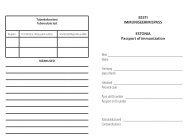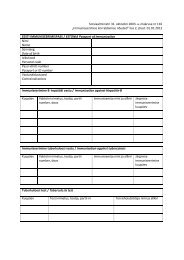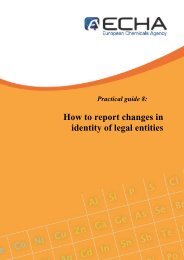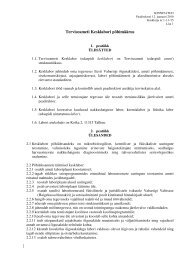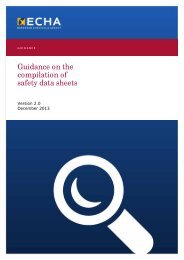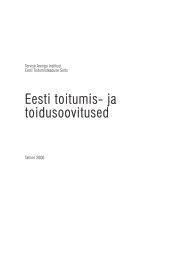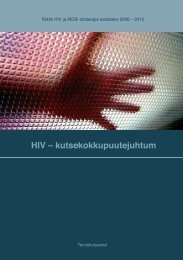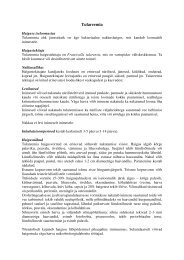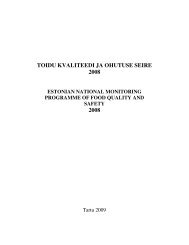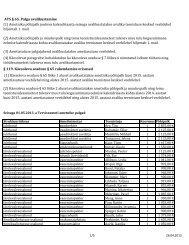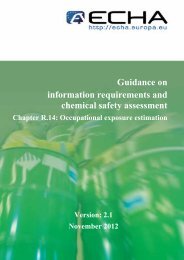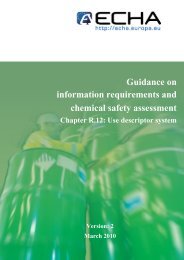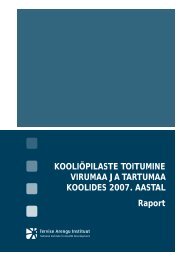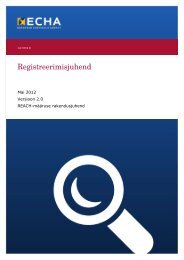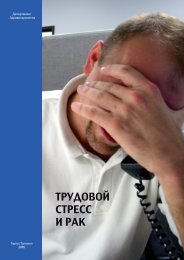Guidance on data sharing - ECHA - Europa
Guidance on data sharing - ECHA - Europa
Guidance on data sharing - ECHA - Europa
You also want an ePaper? Increase the reach of your titles
YUMPU automatically turns print PDFs into web optimized ePapers that Google loves.
<str<strong>on</strong>g>Guidance</str<strong>on</strong>g> <strong>on</strong> <strong>data</strong> <strong>sharing</strong><br />
Versi<strong>on</strong> 2.0 April 2012<br />
45<br />
These activities can involve a review of all available <strong>data</strong> (including publicly available <strong>data</strong>). This review can<br />
be delegated to <strong>on</strong>e individual member (or to an external expert), subject to the assent of others. This may<br />
allow participants to determine and agree <strong>on</strong> classificati<strong>on</strong> and labelling, selecti<strong>on</strong> of studies and testing<br />
proposals to be submitted, to agree the c<strong>on</strong>tent of a possible joint chemical safety report and guidance for<br />
safe use, etc. C<strong>on</strong>sequently, it is recommended that SIEF members work together in the identificati<strong>on</strong> of<br />
existing informati<strong>on</strong> (including publicly available <strong>data</strong>) and <strong>data</strong> needs, the generati<strong>on</strong> of new informati<strong>on</strong>,<br />
and the preparati<strong>on</strong> of the joint registrati<strong>on</strong> dossier (“collective route”). This opti<strong>on</strong> is acknowledged as<br />
being very time-c<strong>on</strong>suming, so lead registrant and SIEF participants are free to organise themselves for the<br />
benefit of all. However the criteria of fairness, transparency and n<strong>on</strong> discriminati<strong>on</strong> must always prevail in<br />
the negotiati<strong>on</strong>s.<br />
In case there is a disagreement regarding a specific endpoint, a potential registrant has according to Article<br />
11(3), the possibility to opt out from the joint submissi<strong>on</strong> for the particular endpoint. Subsequently the potential<br />
registrant does not have to rely up<strong>on</strong> the full <strong>data</strong> set prepared and may submit <strong>data</strong> he already owns<br />
or which he c<strong>on</strong>siders is more scientifically reliable, relevant and adequate, than the <strong>data</strong> chosen in the jointly<br />
submitted dossier. Opting out does not relieve the potential registrant from his obligati<strong>on</strong> to make available<br />
and share <strong>data</strong> or to be part of the joint submissi<strong>on</strong>.<br />
3.3.2 Fulfil the informati<strong>on</strong> requirements for Registrati<strong>on</strong><br />
Data <strong>sharing</strong> must first be reviewed with reference to the informati<strong>on</strong> requirements for Registrati<strong>on</strong>. Essentially,<br />
REACH requires manufacturers and importers to collect <strong>data</strong> <strong>on</strong> the substances they manufacture<br />
or import, to use these <strong>data</strong> to assess the risks related to these substances and to develop and recommend<br />
appropriate risk management measures for using the substance throughout its life cycle. Documenting these<br />
obligati<strong>on</strong>s requires them to submit a registrati<strong>on</strong> dossier to <strong>ECHA</strong>.<br />
Fulfilling the informati<strong>on</strong> requirements for Registrati<strong>on</strong> is essentially a four step process, which c<strong>on</strong>sists of:<br />
• Gathering existing informati<strong>on</strong><br />
• C<strong>on</strong>sidering informati<strong>on</strong> requirements<br />
• Identifying informati<strong>on</strong> gaps<br />
• Generating new informati<strong>on</strong> or submitting a testing proposal in line with REACH obligati<strong>on</strong>s<br />
The participants of the SIEF are free to organise these steps as they best see fit.<br />
3.3.3 The collective route<br />
It is important to stress that REACH gives potential registrants the flexibility to decide how they organise<br />
their <strong>data</strong> <strong>sharing</strong> and joint submissi<strong>on</strong> obligati<strong>on</strong>s. This secti<strong>on</strong> of the <str<strong>on</strong>g>Guidance</str<strong>on</strong>g> describes how <strong>data</strong> <strong>sharing</strong><br />
can be organised collectively within a SIEF with the view to meet the objectives discussed in secti<strong>on</strong> 3.3.1<br />
above, including both the obligati<strong>on</strong>s related to <strong>data</strong> <strong>sharing</strong> and the preparati<strong>on</strong> for the joint submissi<strong>on</strong> of<br />
<strong>data</strong> at Registrati<strong>on</strong>.<br />
The following steps are <strong>on</strong>ly indicative:<br />
• Step 1 Individual gathering of available informati<strong>on</strong> to potential registrants<br />
• Step 2 Agreement <strong>on</strong> the form of cooperati<strong>on</strong>/cost <strong>sharing</strong> mechanism



